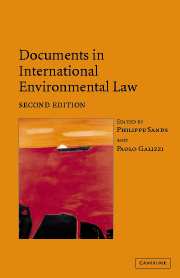Book contents
- Frontmatter
- Contents
- Preface
- PART I General instruments
- PART II Atmosphere
- 5 Convention on Long-Range Transboundary Air Pollution, 13 November 1979
- 5A Protocol to the 1979 Convention on Long-Range Transboundary Air Pollution on Further Reduction of Sulphur Emissions, 14 June 1994
- 5B Non-Compliance Procedure
- 6 Convention for the Protection of the Ozone Layer, 22 March 1985
- 6A Montreal Protocol on Substances that Deplete the Ozone Layer, 16 September 1987
- 6B Non-Compliance Procedure
- 7 United Nations Framework Convention on Climate Change, 9 May 1992
- 7A Kyoto Protocol to the United Nations Framework Convention on Climate Change, 11 December 1997
- 7B Marrakech Accords (extracts)
- PART III Oceans: global
- PART IIIB Oceans: regional
- PART IV Freshwater resources
- PART V Biodiversity
- PART VIA Hazardous substances and activities: nuclear
- PART VIB Hazardous substances and activities: pesticides
- PART VIC Hazardous substances and activities: waste
- PART VII Human rights and the environment
- PART VIII War and the environment
- PART IX Trade and the environment
- PART X Environmental impact assessment and access to information
- PART XI Liability for environmental damage and breaches of environmental obligations
- PART XII The Antarctic
5A - Protocol to the 1979 Convention on Long-Range Transboundary Air Pollution on Further Reduction of Sulphur Emissions, 14 June 1994
Published online by Cambridge University Press: 05 June 2012
- Frontmatter
- Contents
- Preface
- PART I General instruments
- PART II Atmosphere
- 5 Convention on Long-Range Transboundary Air Pollution, 13 November 1979
- 5A Protocol to the 1979 Convention on Long-Range Transboundary Air Pollution on Further Reduction of Sulphur Emissions, 14 June 1994
- 5B Non-Compliance Procedure
- 6 Convention for the Protection of the Ozone Layer, 22 March 1985
- 6A Montreal Protocol on Substances that Deplete the Ozone Layer, 16 September 1987
- 6B Non-Compliance Procedure
- 7 United Nations Framework Convention on Climate Change, 9 May 1992
- 7A Kyoto Protocol to the United Nations Framework Convention on Climate Change, 11 December 1997
- 7B Marrakech Accords (extracts)
- PART III Oceans: global
- PART IIIB Oceans: regional
- PART IV Freshwater resources
- PART V Biodiversity
- PART VIA Hazardous substances and activities: nuclear
- PART VIB Hazardous substances and activities: pesticides
- PART VIC Hazardous substances and activities: waste
- PART VII Human rights and the environment
- PART VIII War and the environment
- PART IX Trade and the environment
- PART X Environmental impact assessment and access to information
- PART XI Liability for environmental damage and breaches of environmental obligations
- PART XII The Antarctic
Summary
Editorial note
Negotiations under the auspices of the 1985 Sulphur Protocol resulted in the conclusion of the 1994 Oslo Protocol on Further Reduction of Sulphur Emissions, which entered into force on 5 August 1998. Like its predecessor, the 1994 Protocol contemplates future negotiations on further obligations to reduce sulphur emissions. The 1994 Protocol applies and develops the concepts of ‘critical loads’ and the ‘effects-based approach’ introduced in the 1988 NOx Protocol. The basic obligation to which the Parties commit is to ‘control and reduce their sulphur emissions in order to protect human health and the environment from adverse effects, in particular acidifying effects, and to ensure, as far as possible, without entailing excessive costs, that depositions of oxidised sulphur compounds in the long term do not exceed critical loads for sulphur given, in annex I, as critical sulphur depositions, in accordance with present scientific knowledge’ (Article 2(1)).
As a first step, parties are required to meet the targets and timetable for reductions of sulphur emissions specified in Annex II (Article 2(2) and (3)). The Protocol requires the parties to make use of the ‘most effective measures for the reduction of sulphur emissions’ from new and existing sources, including controlling the sulphur content of fuel, energy efficient measures, promotion of renewable energy and the application of best available control technologies using the guidance provided in Annex IV of the Protocol (Article 2(4)).
- Type
- Chapter
- Information
- Documents in International Environmental Law , pp. 44 - 58Publisher: Cambridge University PressPrint publication year: 2004



